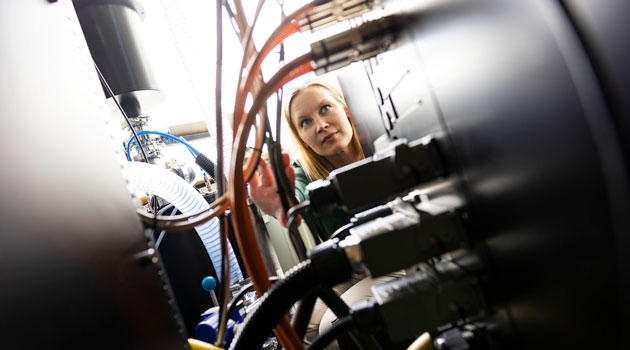Designing tomorrow’s human spare parts
Age, injury or disease: regardless of the cause, there is a growing need for treatments to replace bone and other body parts. Researchers at Uppsala University are using 3D printers to develop tomorrow’s biomaterials.
“Additive manufacturing is fun because you can do so many cool things and it triggers people’s innovation,” enthuses materials researcher Cecilia Persson.
Perhaps the dream of eternal life does not loom quite as large as the promise of at least living a pain-free one. Replacing carefully selected parts that are wholly or partly seized up is already possible in practice, and the limits to which human body parts we can manufacture are being increasingly extended.
Over recent years, additive manufacturing, or 3D printing, has made significant strides. Researchers from our own Department of Materials Science and Engineering at the Ångström Laboratory are among those responsible for one of the major breakthroughs: a 3D-printed titanium-mesh cranial implant that assists bone regeneration.
Restoring major bone deficiencies
degradable components that generate loadbearing
bones. Photo: Mikael Wallerstedt
Another research group from the same department is currently studying the possibility of restoring major bone deficiencies or worn-out backs using 3D-printed components. Although current versions are not degradable, it is hoped that it will be possible to develop degradable components that generate load-bearing bones. The key to success is soluble metals.
“The most studied degradable materials are either polymers or ceramics,” says Cecilia Persson, “but polymers are not rigid enough and ceramics are too fragile and can’t be bent. This is why we want to print metal materials that break down over time.”
The idea is to insert replacement metal components where bone has degenerated or been damaged. As the metal degrades, the body’s own bone grows together. The challenge lies in finding the right metal composite material.
“The metals we are looking at react in aqueous solutions, which is why we want to use them,” explains Cecilia Persson, “but when used for printing they are also typically likely to react with the oxygen in the atmosphere, causing oxidisation that makes printing difficult. So, it’s important to control oxygen content if we are to print functional materials.”
A combined 3D scanner and printer
To aid the researchersin their quest, they now have a combined 3D scanner and printer that ticks their list of requirements. This impressive machine, which has a heating bed capable of reaching 800°C, takes up a substantial part of the lab. Cecilia Persson explains that this model is better suited to research than their previous laser printers. With greater possibilities to adjust settings, the researchers can evaluate crucial parameters to obtain the best possible material quality, in terms of density and microstructure, for example.
“We are currently looking at magnesium-based alloys with structures tailored to the patient. The primary focus is on obtaining the right material composition. After that, we can make increasingly complex designs and structures,” says Cecilia Persson.
Designing organ and tissue-like structures
Are there any limits to which human body parts we can potentially print out? The answer to that question may well lie with fellow researchers in the fields of medicine and pharmacy. Their U-PRINT 3D printing facility specialises in designing and fabricating organ and tissue-like structures for biomedical research, with the long-term aim of finding applications in regenerative medicine. Printouts are currently used as training models for surgical procedures or to evaluate new materials and drugs.
“U-PRINT can print objects in plastic for the hospital, so they can visualise the physical problem or show relatives how an operation will be performed,” says Cecilia Persson. “In fact, 3D printing is an ideal technology for many areas of research. It’s very exciting to see how new areas of application are constantly arising.”
Anneli Björkman
Additive manufacturing
The Vinnova-funded competence centre Additive Manufacturing for the Life Sciences (AM4Life) at Uppsala University hosts researchers working in two disciplinary domains: Science and Technology, and Medicine and Pharmacy. The centre focuses on research and education in new technologies for 3D-printing of objects such as complex structures to improve bioprocesses, improving the reproducibility of 3D tumour models and the rapid optimisation of medication.

